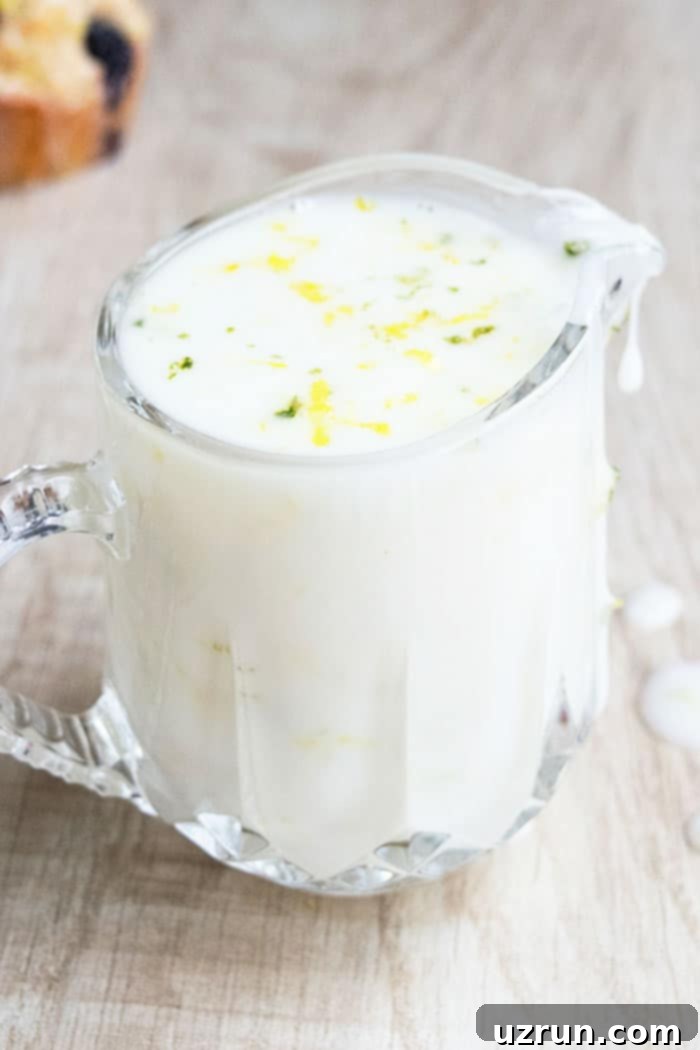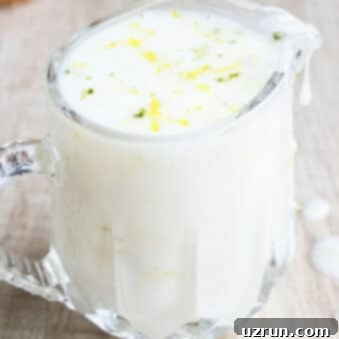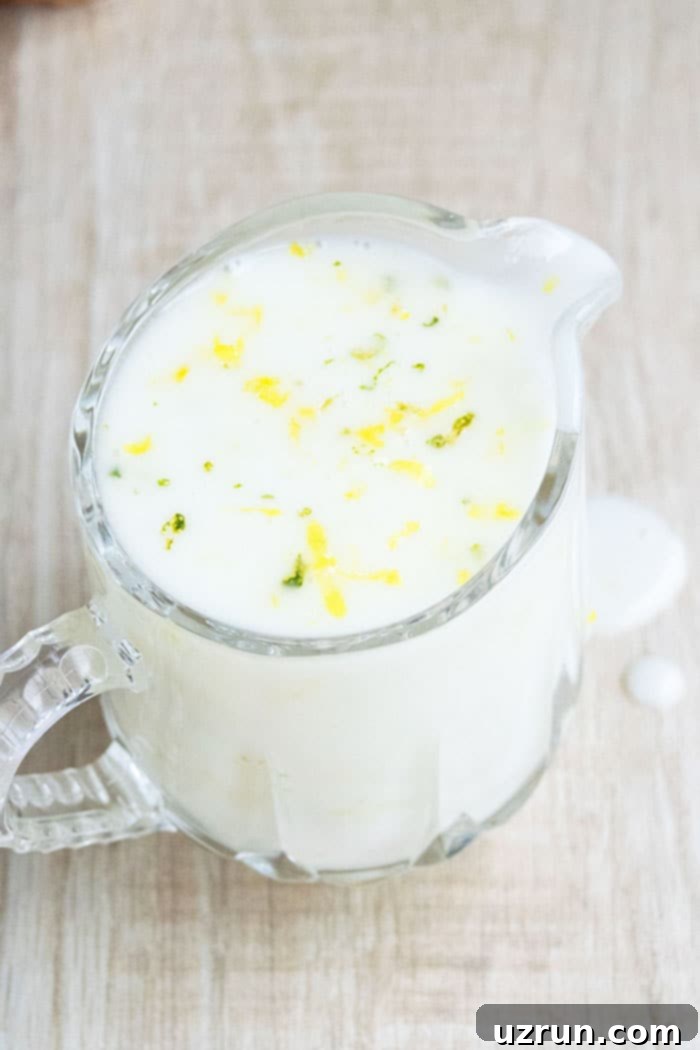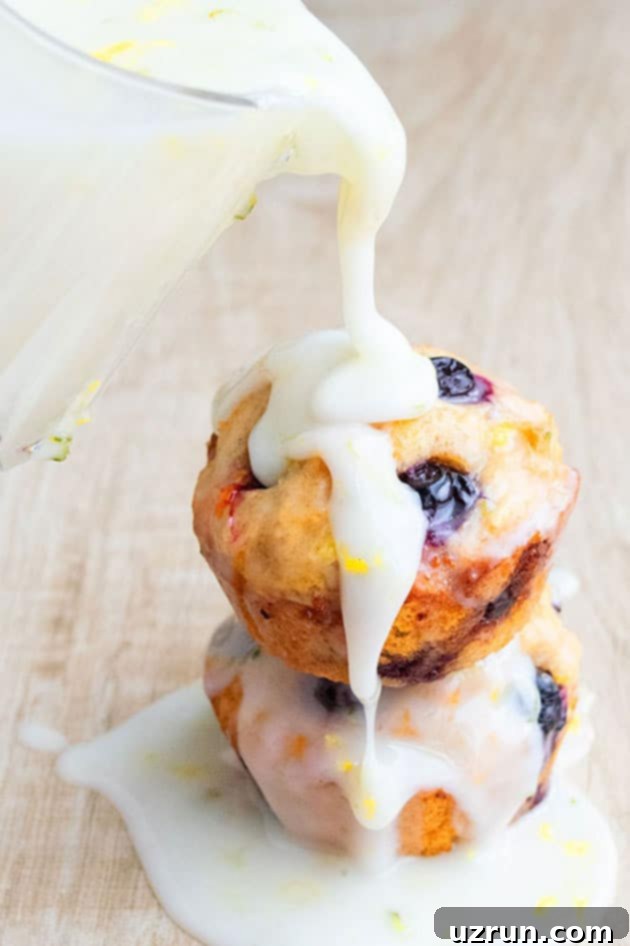Easy Homemade Lemon Glaze Recipe: The Ultimate Drizzle Icing for Cakes, Muffins & More
Unlock the secret to incredibly delicious and beautifully presented baked goods with this quick and easy homemade lemon glaze recipe. Perfect for adding a burst of tangy sweetness, this lemon drizzle icing is crafted from simple, everyday ingredients like fresh lemon juice, aromatic zest, creamy butter, and powdered sugar. It dries to a delightful semi-hard finish, making it the ideal topping for a wide array of treats, including classic pound cakes, elegant bundt cakes, delicate cookies, fluffy muffins, and rustic scones. This versatile glaze is not just about flavor; it’s about elevating your baking with a professional touch and an irresistible citrus aroma.
This light and vibrant lemon glaze provides a harmonious balance of tangy and sweet notes, transforming your cakes and other confections into culinary masterpieces. It’s the perfect finishing touch, not only enhancing the flavor profile but also contributing to a stunning presentation that will impress your guests. While this recipe focuses on a delightful lemon flavor, you can explore other fantastic glazes for similar visual appeal with different tastes. Consider a classic Powdered Sugar Glaze {Vanilla Cake Glaze} for a subtle sweetness, a rich Coffee Glaze (In Mocha Brownie Recipe), or a festive Cranberry Orange Scones {With Orange Glaze} for a citrusy alternative. If your craving for lemon leans towards a thicker, more substantial topping, then you must try a velvety smooth Lemon Buttercream. It’s important to note the distinct differences: glazes are typically poured or spooned over baked goods, creating a thin, shiny coat, whereas buttercream frosting is spread generously with a spatula, offering a rich, creamy texture.
How To Make Easy Lemon Glaze From Scratch?
Creating this homemade lemon glaze is incredibly simple and requires just a few minutes. Follow these straightforward steps to achieve a perfectly smooth and flavorful drizzle:
- Gather and Whisk Ingredients: In a medium mixing bowl, combine your sifted powdered sugar, melted salted butter, freshly squeezed lemon juice, a hint of lemon extract (for intensified flavor), and finely grated lemon zest. Use a whisk to blend everything together until the mixture is completely smooth and free of any lumps. The zest is crucial here as it releases essential oils, contributing significantly to the bright lemon aroma and taste.
- Adjust Consistency (Thin/Thicken): The beauty of this glaze is its adaptability. Start with the recommended amount of lemon juice. If you prefer a thinner, more translucent glaze that gently seeps into your cake, gradually add a few more drops of lemon juice until it reaches your desired pourable consistency. Conversely, if the glaze appears too thin or you prefer a thicker, more opaque coating, simply incorporate more sifted powdered sugar, a tablespoon at a time, until it thickens to your liking. Always adjust gradually to avoid over-thinning or over-thickening.
- Drizzle and Enjoy: Once your glaze has reached the perfect consistency, it’s ready to be applied. Gently drizzle it over your cooled cakes, muffins, cookies, or any other baked goods. The slow, controlled pour ensures an even and aesthetically pleasing finish. Allow it a few minutes to set semi-hard, then prepare to savor the delightful lemon tang!
Do You Put Glaze On Warm Cake Or Cool Cake?
For the best results with most glazes, including this lemon drizzle, it is always recommended to apply it to a **cool cake**. There’s a good reason for this: if you pour glaze over a warm or hot cake, the heat will cause the glaze to melt and slide right off the sides, creating a runny, messy puddle rather than an even, appealing coating. Furthermore, a warm cake will absorb too much of the liquid, potentially making the cake itself soggy where the glaze was applied, compromising both texture and presentation.
The only exception to this rule is if a specific recipe explicitly calls for glazing a warm cake, often when the intention is for the icing to seep through and infuse the cake with moisture and flavor. This technique is sometimes used for dense baked goods like certain fruit cakes, such as this Christmas Fruit Cake {With Cake Mix}, where the goal isn’t a hard, external shell but rather internal saturation. For your standard lemon glaze, however, patience is key – always wait for your baked goods to cool completely.
How Do You Glaze A Bundt Cake? Pound Cake? Cupcakes? Cookies?
Glazing various baked goods effectively requires a simple setup that ensures an even coat and easy cleanup. The most efficient method involves using a cooling rack placed over a baking tray. This setup allows any excess glaze to drip onto the tray below, preventing sticky counters and conserving glaze that can be reused if desired.
- Bundt Cakes and Pound Cakes: Once your bundt or pound cake is completely cool, carefully place it on the cooling rack setup. For an elegant drizzle, use a spoon or a piping bag with a small hole to gently cascade the glaze over the top, letting it naturally run down the sides. For a more complete coating, you can pour the glaze more generously, ensuring it covers the entire surface.
- Cupcakes: For cupcakes, you can either dip the cooled tops directly into a bowl of glaze, twisting slightly for an even coat, or use a spoon to drizzle artistic patterns over each one. The cooling rack is still useful here to catch drips.
- Cookies: For cookies, a thinner glaze works wonderfully. You can dip one side of each cooled cookie into the glaze, or use a small spoon or pastry brush to spread a thin, even layer. For intricate designs, a piping bag with a very fine tip can be used. Allow cookies to set on the cooling rack for the glaze to harden properly.
The baking tray underneath is your best friend here, collecting all the drips and making post-baking cleanup a breeze!
Why Is My Lemon Glaze Runny? How To Fix It?
A runny lemon glaze is a common issue, and it almost always indicates that there’s simply too much liquid in your mixture. This can happen if you accidentally add too much lemon juice or butter, or if your powdered sugar wasn’t sifted properly, leading to less volume. The good news is, it’s very easy to fix! To achieve the perfect consistency, gradually add a little more sifted powdered sugar, one tablespoon at a time, whisking thoroughly after each addition. Continue this process until the glaze thickens to your desired pourable, yet coating, consistency. Remember to add slowly and whisk well to avoid over-thickening.
Why Is My Glaze So Thick? How To Fix It?
Conversely, if your lemon glaze is too thick, it means you’ve added an excess of powdered sugar. This can result in a glaze that’s difficult to drizzle and might crack when set. To thin it out, simply add more lemon juice, a teaspoon at a time, whisking continuously until the mixture achieves a smooth, fluid consistency that’s easy to work with. Be conservative with your additions, as a little liquid goes a long way in thinning the glaze, and you want to maintain that vibrant lemon flavor.
Why Is My Glaze Grainy?
A grainy glaze is often the result of using the wrong type of sugar or not preparing it correctly. To achieve that coveted smooth, velvety finish, you must use **powdered sugar** (also known as confectioners’ sugar or icing sugar), not granulated sugar. Granulated sugar crystals will not dissolve properly in the glaze, leaving you with an unpleasantly gritty texture. Additionally, to prevent any small lumps that can lead to graininess, always be sure to sift your powdered sugar thoroughly before adding it to your other ingredients. Sifting ensures a fine, uniform powder that dissolves seamlessly into a smooth, glossy glaze.
How To Store Desserts With This Lemon Glaze?
Once your delicious baked goods are adorned with this lemon glaze, proper storage is key to maintaining their freshness and flavor. Most desserts glazed with this semi-hard icing can be stored in an airtight container at room temperature for up to 2 days, especially if your kitchen isn’t overly warm. For extended freshness, particularly in warmer climates or if your dessert contains perishable ingredients (like fresh fruit), refrigerating the sealed container for up to 2 days is a better option. Always ensure the glaze has fully set before covering to prevent sticking and smudging.
Does Lemon Glaze Icing Harden?
Yes, this lemon glaze will partially harden, but it won’t become brittle like royal icing. The specific ratio of powdered sugar to fat (butter) and liquid (lemon juice) in this recipe is designed to create a semi-hard, stable finish. The high sugar content allows it to set, providing a protective and appealing outer layer, while the presence of butter and lemon juice keeps it from becoming completely rigid, ensuring it remains pleasantly soft enough to bite through without cracking your dessert. It offers a satisfying slight resistance when touched, perfect for handling and stacking.
Why Is My Glaze Not White?
If you’re aiming for a pure white glaze and find yours has a faint yellow tint, it’s due to the natural color of fresh lemon juice. While it adds vibrant flavor, lemon juice itself has a pale yellow hue that subtly tints the white powdered sugar. The only way to achieve a truly pristine white glaze with a lemon flavor is to replace the lemon juice with clear liquids like milk or water, and then flavor it exclusively with lemon zest or a clear lemon extract. However, be aware that this alteration will likely result in a less intense and less authentic fresh lemon flavor compared to using actual lemon juice, sacrificing some of that zesty punch for color.
Clear Lemon Glaze vs. Opaque Drizzle Icing
It’s important to distinguish between this opaque, powdered sugar-based lemon drizzle icing and what is often referred to as a “clear lemon glaze.” A clear lemon glaze is typically a lemon sugar syrup, fundamentally different from this recipe. It involves cooking granulated sugar with lemon juice, zest, and water on the stovetop until the sugar dissolves and the mixture thickens slightly, creating a translucent, glistening syrup. This syrup is usually brushed onto cakes while warm to add moisture and a subtle sheen, rather than drizzled for an opaque coating. While both provide a lemon flavor, they serve different textural and aesthetic purposes.
Creative Ways to Use Lemon Glaze: Perfect Pairings
This versatile lemon glaze is the perfect complement to a myriad of baked goods, adding a touch of brightness and sweetness that elevates every bite. Here are some of our favorite ways to use it:
Bundt Cakes – A generous drizzle looks stunning and adds moisture to classics like this Lemon Bundt Cake, or provides a zesty contrast to a rich Chocolate Bundt Cake.
Pound Cakes – The semi-hard glaze is ideal for a sturdy pound cake, enhancing the flavor of a Lemon Pound Cake, a comforting Buttermilk Pound Cake, an indulgent Cream Cheese Pound Cake, or a classic Sour Cream Pound Cake.
Cakes – Transform simple cakes into showstoppers. Try it on Homemade Funnel Cake, brighten up a Strawberry Shortcake Cake, add a zing to 7 Up Cake {With Cake Mix}, complement a Best Vanilla Cake Recipe {From Scratch}, or double down on citrus with a Moist Lemon Cake Recipe.
Muffins – A light glaze takes muffins from breakfast staple to special treat. Excellent on Cranberry Orange Muffins, Pancake Muffins, or to enhance the fruit in Lemon Blueberry Muffins.
Sweet Breads – A simple glaze can elevate any sweet loaf, such as this moist Orange Cranberry Bread or an Easy Banana Bread for a surprising twist.
Scones – A delicate drizzle adds an extra layer of flavor and moisture to flaky scones, especially these Cranberry Orange Scones.
Cookies – A thin coating provides a delightful snap and intense flavor. Try it on Pistachio Cookies, Easy Heart Cookies, rich Cream Cheese Cookies, to double the lemon in Easy Lemon Cookies, or a delightful contrast to Gooey Butter Cookies.
Breakfast Foods – Add a gourmet touch to your morning favorites like fluffy Lemon Blueberry Pancakes {So Fluffy}, crispy Lemon Blueberry Waffles, or even jazzed-up Cinnamon French Toast Sticks.
Dump Cakes – A simple drizzle can add a layer of sophistication to easy desserts like this Blueberry Dump Cake {Blueberry Cobbler Dump Cake}.
Cupcakes – A beautiful alternative to heavy frosting. Perfect for Strawberry Cupcakes {Soft And Moist}, refreshing Blueberry Cupcakes, to enhance Lemon Cupcakes, or a simple finish for a Best Vanilla Cupcake.
Elevate Your Lemon Glaze: Delicious Variations and Flavor Twists
While this classic lemon glaze is perfect on its own, it also serves as an excellent base for creative flavor variations. Don’t be afraid to experiment and customize it to match your dessert or mood:
- Add Food Coloring: For themed parties or holidays, a few drops of liquid or gel food coloring can transform your glaze. Think pastel yellow for spring, vibrant green for a lime twist, or even a soft pink for a strawberry-lemon combination.
- Incorporate Other Zests: While lemon zest provides a powerful punch, try replacing half the lemon zest with orange zest for a sweeter, more mellow citrus profile, lime zest for an extra tangy kick, or even grapefruit zest for a sophisticated, slightly bitter edge. Each addition brings its unique aromatic complexity.
- Infuse with Spices or Herbs: For a more adventurous palate, a pinch of ground ginger can add warmth, a touch of anise can introduce a subtle licorice note, or for a truly savory-sweet twist, finely minced rosemary or basil can offer an unexpected herbaceous brightness that pairs surprisingly well with lemon.
- Stir in Shredded Coconut: To add delightful texture and a hint of tropical sweetness, mix in a tablespoon or two of finely shredded coconut. This works exceptionally well on coconut-flavored cakes or muffins.
- Add Cocoa Powder: For an intriguing “lemony chocolate” glaze, whisk in a small amount of unsweetened cocoa powder. Start with a teaspoon and add more to taste, adjusting the liquid slightly if needed to maintain consistency.
- Experiment with Other Extracts: Swap out or complement the lemon extract with other flavorings. Almond extract adds a sophisticated, nutty undertone, maple extract offers a cozy warmth, pure vanilla extract softens the citrus notes, and orange extract can brighten the overall profile.
- Blend in Fruit Puree: For natural color and a layered fruit flavor, gently fold in a small amount of strained strawberry, raspberry, or blueberry puree. Be mindful that fruit purees add liquid, so you may need to adjust the amount of lemon juice or powdered sugar to maintain the desired consistency.
Expert Tips and Techniques for the Best Lemon Glaze
Achieving a consistently perfect lemon glaze every time is easy when you follow these expert tips and techniques:
- Use Salted Butter: While unsalted butter is often preferred in baking, salted butter actually helps to cut through the intense sweetness of the powdered sugar in this glaze. This subtle saltiness creates a more balanced flavor profile, preventing the glaze from being cloyingly sweet and allowing the bright lemon notes to truly shine.
- Opt for Freshly Squeezed Lemon Juice: This is a non-negotiable for the best results! Store-bought lemon juice, while convenient, often lacks the vibrant, fresh, and complex flavor of juice squeezed directly from a ripe lemon. Fresh juice provides the brightest, most authentic lemon taste that makes all the difference.
- Do Not Omit the Zest: Lemon zest is where a significant portion of the lemon’s essential oils and intense flavor reside. Combining the zest with the juice creates a robust, multi-dimensional lemon flavor that cannot be achieved with juice alone. It adds depth and aromatic complexity.
- Whisk Until Smooth and Glossy: Thorough whisking is vital. Continue to whisk your glaze vigorously until it is completely smooth, lump-free, and has a beautiful glossy sheen. This not only ensures a pleasant mouthfeel but also contributes to an attractive, professional-looking finish on your baked goods.
- Pour Glaze Slowly and Deliberately: When applying the glaze, do so slowly and with control. Pouring too quickly can drench your dessert, creating an overly thick and heavy layer, or causing it to run off unevenly. A slow, steady stream allows you to control the coverage and achieve an elegant drizzle or a thin, even coat.
- Always Sift Powdered Sugar: This simple step makes a world of difference in preventing a grainy or lumpy glaze. Powdered sugar often compacts and forms small lumps in its packaging. Sifting it breaks up these lumps, ensuring that it incorporates smoothly and dissolves perfectly, resulting in an ultra-smooth, velvety consistency for your glaze.
Storage of Your Homemade Lemon Glaze
Proper storage ensures you can enjoy this bright lemon glaze whenever a craving strikes:
- Make Ahead Instructions: You can easily prepare this lemon glaze in advance. Follow the recipe below to mix all ingredients, then store the prepared glaze in a sealed, airtight container in the refrigerator for up to 2 days. When you’re ready to use it, simply give it a good whisk again, as it may separate slightly or thicken in the fridge, bringing it back to its smooth, pourable consistency.
- Refrigerate: Any leftover glaze can be stored in a sealed container in the fridge for up to 2 days. Always re-whisk before using.
- Freeze: Freezing this particular lemon glaze is generally not recommended. The consistency and texture are likely to become watery and separate upon thawing, making it unsuitable for drizzling and compromising the desired smooth finish. It’s best enjoyed fresh or stored short-term in the refrigerator.
More Zesty Lemon Desserts to Explore
If you love the bright, tangy flavor of lemon, be sure to check out these other delightful lemon-infused dessert recipes:
- Easy Lemon Bars {Lemon Squares}
- Lemon Meringue Pie
- Lemon Cake Balls {Cake Truffles}
- Lemon Fudge {2 Ingredients}

Recipe

Lemon Glaze For Cake (Lemon Drizzle Icing)
Abeer Rizvi
Pin Recipe
Want to Save This Recipe?
Enter your email & I’ll send it to your inbox. Plus, get great new recipes from me every week!
By submitting this form, you consent to receive emails from CakeWhiz
Ingredients
- 2 cups Powdered sugar Sifted
- 1 tablespoon Butter Salted, Melted
- 2-4 tablespoon Lemon juice Freshly squeezed
- ½ teaspoon Lemon extract
- 2 teaspoon Lemon zest Can replace half the amount with lime zest for an added flavor
Instructions
-
In a large mixing bowl, add sifted powdered sugar, melted butter, lemon juice, lemon extract, lemon zest and whisk it altogether until glaze is smooth and glossy.
-
Start with 2 tablespoon lemon juice and add more to thin out the glaze to your preference. If icing is too thin, mix in some more powdered sugar.
-
Drizzle it on top of your cool cakes or other baked goods and enjoy.
Notes
- Read all my tips above for the best results and troubleshooting common issues.
- Leftovers of the glaze can be stored in a sealed container in the fridge for up to 2 days but will need to be whisked again thoroughly to restore its smooth consistency prior to being used.
Nutrition
An automated tool is used to calculate the nutritional information. As such, I cannot guarantee the accuracy of the nutritional information provided for any recipe on this site.



